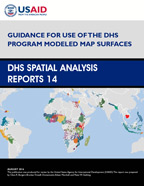- PUBLICATIONS
- JOURNAL ARTICLES
- ACCESS PUBLICATIONS
Publications Summary
- Document Type
- Spatial Analysis Reports
- Publication Topic(s)
- Geographic Information
- Language
- English,French
- Recommended Citation
- Clara R. Burgert-Brucker, Trinadh Dontamsetti, Aileen M. J. Marshall, and Peter W. Gething. 2016. Guidance for Use of The DHS Program Modeled Map Surfaces. DHS Spatial Analysis Reports No. 14. Rockville, Maryland, USA: ICF International
- Download Citation
- RIS format / Text format / Endnote format
- Publication Date
- August 2016
- Publication ID
- SAR14
